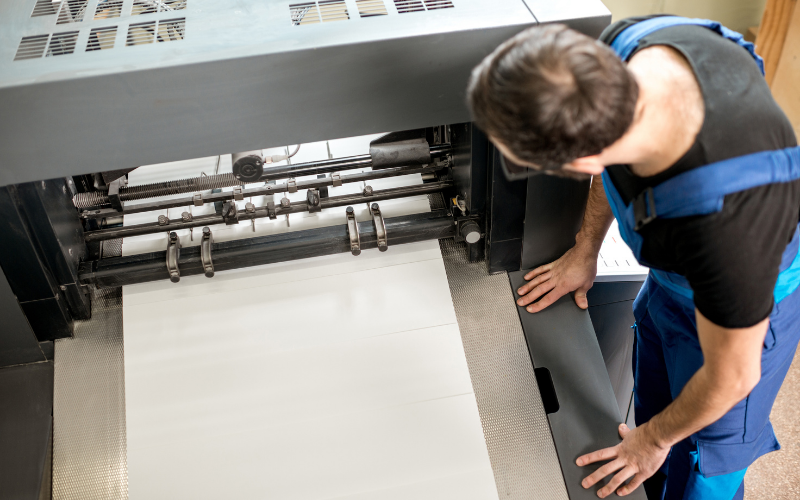
Overview
If you’re interested in working in industries like printing, packaging, design, or creativity, there are various roles you could take on. You might find yourself working on magazines, newspapers, packaging, greeting cards, or even printing on materials like plastics or textiles. Another area you might delve into is producing secure items like passports or ID cards.
As a print operative, your main task is to follow instructions to help produce printed materials using the necessary equipment to meet specific requirements. This job often involves choosing a specialisation within the field, such as pre-press operative, press operative, or post-press operative.
Pre-press operatives typically receive customer files and prepare them for printing, ensuring there are no errors. Press operatives handle setting up the printing press, addressing any issues, and preparing the machinery for printing. Post-press operatives focus on setting up finishing equipment, checking the final output for quality, and noting any problems.
These roles usually involve working in an office or production environment, where you might need protective gear to ensure safety.
What You’ll Do
- Make Sure Things are Ready: Read instructions, set up printing tasks, and make sure everything needed, like machines and materials, are there. If there’s a problem, report it.
- Pick the Right Tools: Choose the best equipment for the job and plan how to get things done efficiently.
- Check What You’ve Got: Make sure the materials you receive match what the job needs before you start.
- Keep Things Running Smoothly: Do basic maintenance on the printing equipment, like ensuring it’s properly calibrated and oiled.
- Speak Up About Any Issues: Report any problems you notice with the printing process’s quality, quantity, or other aspects.
- Keep Records Up to Date: Fill out paperwork and update computer systems with the latest info about what’s been printed and how.
- Make Sure the Final Product is Right: Check that what’s been printed matches the specifications and instructions.
- Help Make Things Better: Be part of the effort to improve how things are done in the printing process.
- Keep the Workplace Clean and Organised: Use techniques like sorting and cleaning to keep the printing area tidy and safe.
What You’ll Learn
- Health and Safety Practices: This covers assessing risks, controlling them, using Personal Protective Equipment (like helmets or goggles), safely handling items, and practising good ergonomics.
- Health and Safety Regulations: These are rules like the Health and Safety at Work Act and regulations for handling hazardous substances.
- Environment and Sustainability: This involves laws like the Environmental Protection Act and understanding the impact of waste disposal and energy efficiency.
- Printing Industry Basics: Learning about the printing and graphic communication industry, including its markets and various organisations.
- Organisational Differences: How different printing companies work, their culture, values, and production methods.
- Printing Processes: Understanding how printing works, ensuring quality, managing materials, and controlling colours.
- Production Cycle: Knowing the entire process from start to finish, meeting quality standards, deadlines, and performance goals.
- Work Instructions: Understanding instructions for using materials, colours, and machines, and reducing waste.
- Problem-Solving Skills: Learning to identify and solve issues with printing machinery, digital tools, and online services.
- Data Security: Keeping information safe and following regulations like GDPR.
- Equality and Diversity: Promoting fairness and diversity in the workplace.
- Work Area Efficiency: Maintaining a clean and organised workspace for better efficiency using methods like 5S.
- Pre-Press Operations: Handling electronic files and preparing them for printing.
- Digital File Management: Checking and processing digital files efficiently.
- Software and Workflow Management: Using software for colour management and ensuring data integrity.
- Proof Creation: Making proofs from client files for approval.
- Equipment Calibration: Ensuring printing equipment produces accurate proofs.
- Software Packages: Understanding software used for design and workflow tasks.
- Press Operations: Preparing, operating, and shutting down print presses safely.
- Materials and Chemicals: Knowing about materials, inks, toners, and chemicals used in printing.
- Handling and Storage: Safely store and handle print materials and chemicals.
- Machine Maintenance: Understanding maintenance needs and risks for printing machinery.
- Post-Press Operations: Learning about print finishing techniques and terminology.
- Printing Materials: Understanding properties and uses of printing materials like paper and adhesives.
- Finishing Equipment: Knowing the types of finishing equipment and safety aspects involved.
- Equipment Maintenance: Understanding maintenance needs and risks for finishing equipment.
